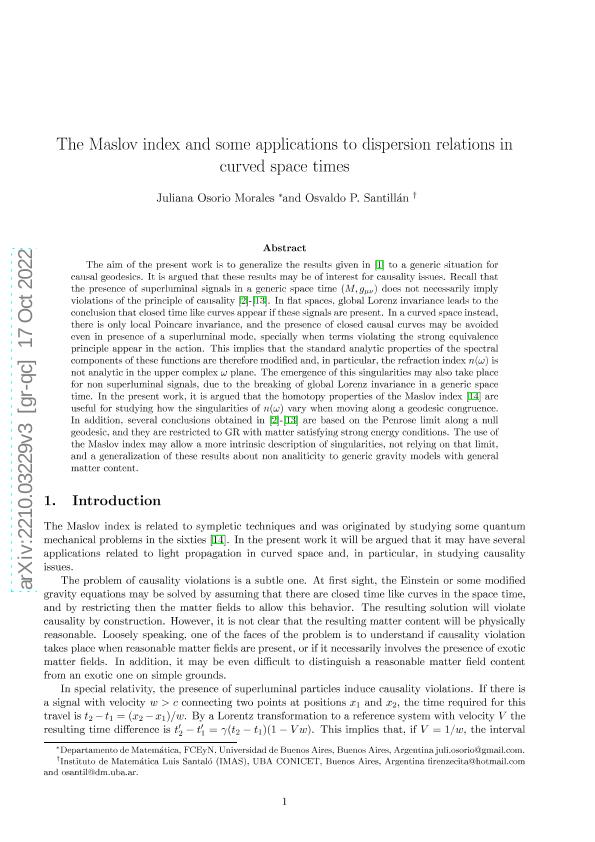Mostrar el registro sencillo del ítem
dc.contributor.author
Osorio Morales, Maria Juliana

dc.contributor.author
Santillán, Osvaldo Pablo

dc.date.available
2024-03-25T12:54:29Z
dc.date.issued
2023-06
dc.identifier.citation
Osorio Morales, Maria Juliana; Santillán, Osvaldo Pablo; The Maslov index and some applications to dispersion relations in curved space times; American Institute of Physics; Journal of Mathematical Physics; 64; 6; 6-2023; 1-33
dc.identifier.issn
0022-2488
dc.identifier.uri
http://hdl.handle.net/11336/231420
dc.description.abstract
The aim of the present work is to generalize the results given in Osorio Morales and Santillán [Eur. Phys. J. C 82, 353 (2022)] to a generic situation for causal geodesics. It is argued that these results may be of interest for causality issues. Recall that the presence of superluminal signals in a generic space time (M, gμν) does not necessarily imply violations of the principle of causality {[G. M. Shore, Nucl. Phys. B 778, 219 (2007)] and [T. J. Hollowood and G. M. Shore, Phys. Lett. B 655, 67 (2007)]}. In flat spaces, global Lorenz invariance leads to the conclusion that closed time-like curves appear if these signals are present. In a curved space instead, there is only local Poincare invariance, and the presence of closed causal curves may be avoided even in the presence of a superluminal mode, especially when terms violating the strong equivalence principle appear in the action. This implies that the standard analytic properties of the spectral components of these functions are therefore modified, and in particular, the refraction index n(ω) is not analytic in the upper complex ω plane. The emergence of these singularities may also take place for non-superluminal signals due to the breaking of global Lorenz invariance in a generic space time. In the present work, it is argued that the homotopy properties of the Maslov index are useful for studying how the singularities of n(ω) vary when moving along a geodesic congruence. In addition, several conclusions obtained in Shore [Nucl. Phys. B 778, 219 (2007)] and Hollowood and Shore [Phys. Lett. B 655, 67 (2007)] are based on the Penrose limit along a null geodesic, and they are restricted to GR with matter satisfying strong energy conditions. The use of the Maslov index may allow a more intrinsic description of singularities, not relying on that limit, and a generalization of these results about non-analyticity to generic gravity models with general matter content.
dc.format
application/pdf
dc.language.iso
eng
dc.publisher
American Institute of Physics

dc.rights
info:eu-repo/semantics/openAccess
dc.rights.uri
https://creativecommons.org/licenses/by-nc-sa/2.5/ar/
dc.subject
MASLOV
dc.subject
INDEX
dc.subject
CONJUGATE
dc.subject
POINTS
dc.subject.classification
Matemática Aplicada

dc.subject.classification
Matemáticas

dc.subject.classification
CIENCIAS NATURALES Y EXACTAS

dc.title
The Maslov index and some applications to dispersion relations in curved space times
dc.type
info:eu-repo/semantics/article
dc.type
info:ar-repo/semantics/artículo
dc.type
info:eu-repo/semantics/publishedVersion
dc.date.updated
2024-03-25T12:31:53Z
dc.journal.volume
64
dc.journal.number
6
dc.journal.pagination
1-33
dc.journal.pais
Estados Unidos

dc.description.fil
Fil: Osorio Morales, Maria Juliana. Consejo Nacional de Investigaciones Científicas y Técnicas. Oficina de Coordinación Administrativa Ciudad Universitaria. Instituto de Investigaciones Matemáticas "Luis A. Santaló". Universidad de Buenos Aires. Facultad de Ciencias Exactas y Naturales. Instituto de Investigaciones Matemáticas "Luis A. Santaló"; Argentina
dc.description.fil
Fil: Santillán, Osvaldo Pablo. Consejo Nacional de Investigaciones Científicas y Técnicas. Oficina de Coordinación Administrativa Ciudad Universitaria. Instituto de Investigaciones Matemáticas "Luis A. Santaló". Universidad de Buenos Aires. Facultad de Ciencias Exactas y Naturales. Instituto de Investigaciones Matemáticas "Luis A. Santaló"; Argentina
dc.journal.title
Journal of Mathematical Physics

dc.relation.alternativeid
info:eu-repo/semantics/altIdentifier/doi/http://dx.doi.org/10.1063/5.0146979
Archivos asociados
